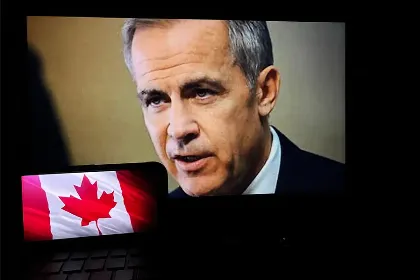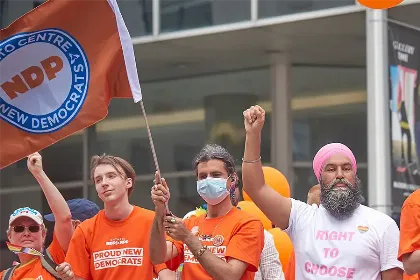
Justin Trudeau’s election in 2015 marked a transformative moment in Canadian politics. His campaign, rooted in promises of progressive change and a fresh approach to leadership, captured the hearts of many Canadians, particularly younger voters. However, nearly a decade later, the political landscape has shifted dramatically. Economic challenges have reshaped young Canadians’ priorities, eroding their support for Trudeau and the Liberal Party. The sunny ways of Justin Trudeau are now over, and it almost looks certain that Trudeau is at the sunset of his political career.
A Sharp Decline in Young Voter Support
Support for the Liberal Party among young Canadians (ages 18–35) has fallen precipitously over the past nine years. In 2015, 41 percent of this demographic backed the Liberals, propelling Trudeau to a majority government. By 2024, that figure had dropped to just 22 percent (Abacus Data, 2024). This 19-point decline is particularly significant given the role young voters played in securing electoral victories for the Liberal Party in in 2015, 2019, and 2021. Without their support, the Liberals face a steep uphill battle to maintain political relevance. Although this decline reflects broader dissatisfaction with the Liberal Party across all age groups, the loss is most pronounced among younger voters. Their waning support highlights a growing frustration with Trudeau’s inability to address their urgent concerns.
The Conservatives Gain Ground
As Liberal support among young Canadians has dwindled, the Conservative Party, under Pierre Poilievre, has filled the void. Currently, 37 percent of young Canadians say they would vote for the Conservatives, a stark contrast to the 22 percent who would still back the Liberals (Abacus Data, 2024). This shift underscores a significant reversal in political alignment, with young Canadians gravitating toward a party they may have previously avoided. The Conservatives’ success lies in their ability to address the economic priorities of young Canadians, positioning themselves as the party most capable of handling the cost of living, housing, and the economy. These issues have eclipsed traditional concerns like climate change and healthcare in the minds of younger voters. Poilievre has made the cost of living the main ballot issue in the next election, successfully capitalizing on the failure of the incumbent Liberal government to address the high costs of living in Canada. Poilievre's famous slogans, axe the tax, bring it home, and fix the budget are all aimed at addressing Canada's cost of living crisis.
Economic Pressures Reshape Priorities
The cost-of-living and housing crises have profoundly impacted young Canadians, reshaping their financial realities and life choices. Many young Canadians have been forced to delay critical milestones, such as purchasing a home, renting, pursuing higher education, getting married, or starting a family. Rising housing costs have pushed some to move in with family or friends, while others have shifted to renting instead of buying. Beyond these long-term sacrifices, young Canadians are also struggling with daily financial challenges. Many report skipping meals, reducing food quality, or selling personal belongings to make ends meet. This precarious economic situation has left nearly half of young Canadians experiencing significant to extreme stress, far more than other age groups (Abacus Data, 2024).
The Liberals’ Disadvantage
The Liberal Party has struggled to regain the trust of young Canadians, who increasingly perceive the party as out of touch with their economic realities. While Trudeau’s government has championed initiatives in areas like climate change and immigration, these efforts have done little to address the immediate financial concerns of younger voters. By contrast, the Conservatives have successfully framed themselves as the party that prioritizes affordability and economic stability, positioning them as the preferred choice for a generation seeking relief.
The Political Implications
The erosion of young voter support for the Liberals signals a critical turning point in Canadian politics. Young Canadians, once the backbone of Trudeau’s electoral success, are now driving a broader realignment of political allegiances. The rise in Conservative support among this demographic underscores the extent to which economic pressures have reshaped the political landscape. For Trudeau and the Liberal Party, the path forward is fraught with challenges. Rebuilding trust with young Canadians will require bold, tangible actions to address the housing and cost-of-living crises. Without this demographic, the Liberals risk fading into irrelevance, marking the potential end of an era for a party once synonymous with youthful optimism and progressive change.
The Conservatives Are in a Great Position to Win the Next Election
The Conservative Party of Canada is way ahead of the Liberals in the polls. According to CBC's poll tracker, the Conservatives are at 44 percent nationally and have a significant lead over the Liberals in every province, while the Liberals are at 20.9 percent nationally. An over 20 percent lead in national polls indicates that the Conservative Party of Canada will likely win a majority government in the next election. The lowest vote share for a majority government in Canadian history was 38.5 percent, which was achieved by the Liberals in the 1997 election. What makes the Liberals in an even weaker electoral position is that the Conservatives lead the Liberals in every province, including the traditional Liberal stronghold of Quebec.
Abacus Data. (2024). Understanding the drift away from the Liberals.



